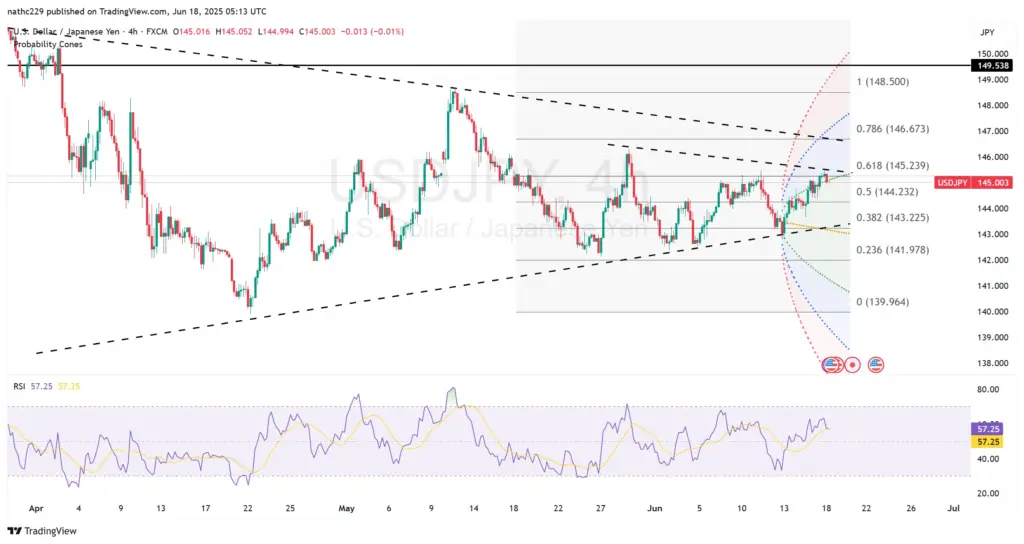USD/JPY Gains Ground as Oil Prices and Central Bank Policies Support Bulls

Overview
USD/JPY has advanced notably in recent trading sessions, bolstered by rising oil prices stemming from geopolitical tensions and accommodative central bank policies. With equities holding steady and yen positioning declining, the market environment increasingly favors USD strength, presenting significant upside risks for the currency pair.
Technical Outlook
USD/JPY currently trades within a narrow Ichimoku cloud range, signaling potential breakout opportunities in the near term. Key technical resistance is established at the Ichimoku base line (145.33), the cloud top (145.59), and the upper Bollinger band (145.59), with a decisive break above these levels likely signaling further bullish potential.
Critical support remains evident at the 21-day moving average at 144.00, the June 13 low at 142.80, and the lower Bollinger band at 142.49. Technical momentum indicators maintain a bullish bias but suggest short-term overbought conditions, warranting caution around key resistance levels.
Influence of Oil Prices and Geopolitical Risks
WTI crude oil prices have surged, increasing over 25% since early May and rising by 2% recently due to ongoing Middle East tensions, particularly the Iran-Israel conflict. Rising oil prices typically weigh heavily on the yen due to Japan's energy dependency, negatively impacting its trade balance and overall economic outlook, thereby supporting USD/JPY.
Geopolitical tensions initially heightened market volatility but have somewhat stabilized as markets currently price in a contained conflict scenario. Nevertheless, ongoing developments require close monitoring, as any sudden escalation could swiftly shift risk sentiment and yen dynamics.
Central Bank Implications
The Bank of Japan recently signaled a dovish shift, announcing plans to slow its balance sheet reduction starting in 2026. This accommodative stance starkly contrasts with the Federal Reserve's current policy outlook, significantly influencing USD/JPY dynamics.
The Federal Reserve is currently meeting to discuss monetary policy, with market consensus largely anticipating rates to remain unchanged. However, any shift in rhetoric toward a more hawkish or dovish stance could significantly affect USD/JPY. Traders will closely scrutinize Fed statements for insights into future policy directions, particularly amid recent mixed U.S. economic data.
Treasury Yields and Economic Data
Recent U.S. economic data, including disappointing retail sales, have contributed to lower Treasury yields, moderating USD strength slightly. However, the overarching narrative of higher oil prices and accommodative monetary policy supports ongoing bullish sentiment for USD/JPY, particularly if yields stabilize or trend higher amid stronger-than-expected economic outcomes.
Positioning and Volatility Dynamics
Yen positioning in futures markets has declined markedly since early May, indicating reduced speculative appetite and diminished demand for the currency. This shrinking positioning aligns with decreasing volatility, as indicated by risk reversals drifting lower, supporting potential upside for USD/JPY.
Risk Factors and Trading Recommendations
Potential risks to the bullish outlook include unexpected geopolitical escalations or significant downturns in global equities, which could boost yen demand. Additionally, any dovish surprises from the Fed could quickly reverse current bullish momentum.
Traders may strategically position for upside breakouts, particularly above the critical resistance at 145.59, targeting subsequent resistance at 146.29. Strict risk management practices are recommended to mitigate potential volatility associated with central bank announcements and geopolitical uncertainties.
Conclusion
USD/JPY maintains a bullish bias, supported by rising oil prices, accommodative BoJ policies, and declining yen positioning. Traders should carefully manage positions around key central bank meetings and evolving geopolitical dynamics to capitalize on potential opportunities.
